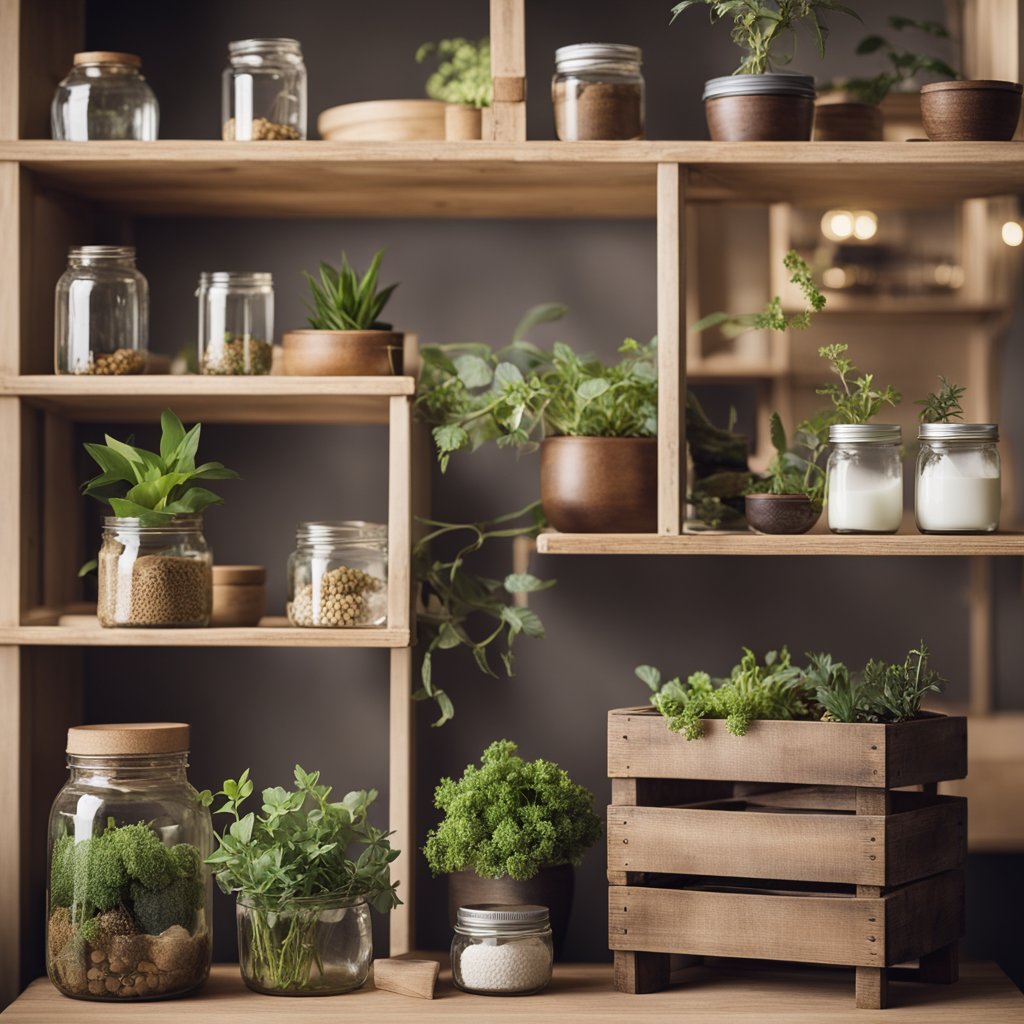How to Repurpose Old Items and Reduce Waste in Your Home: Practical Tips for Sustainable Living
By Alex Reynolds |

How to Repurpose Old Items and Reduce Waste in Your Home: Practical Tips for Sustainable Living
Many people want to make their homes more sustainable but may not know where to start. Repurposing old items is an effective way to cut down on waste while adding unique touches to a home. By transforming what they already own into something new, they can lessen their environmental impact and save money.
Creative repurposing can be simple and fun. For example, furniture can be updated with a coat of paint or transformed into a new piece altogether. Items like old jars can be turned into organizers, while worn-out clothes can become rags or even new accessories.
In addition to saving money, these practices encourage a thoughtful approach to consumption. People can reflect on what they truly need and find value in what might otherwise be discarded. This not only helps the environment but also sparks creativity and personal expression in their living spaces.
The Importance of Repurposing and Waste Reduction
Repurposing old items and reducing waste has many benefits. It not only helps the environment but also brings economic and social advantages. Making small changes can have a big impact on the world.
Environmental Benefits
Repurposing helps decrease the amount of waste that goes into landfills. Less waste means fewer harmful chemicals released into the soil and air. By finding new uses for items instead of throwing them away, people can reduce their carbon footprint.
Moreover, repurposing can lessen the need for new products. This reduces resource extraction, which can harm ecosystems. Using less material contributes to conservation efforts and protects wildlife habitats.
Economic Advantages
Repurposing can save money and generate income. Repairing or redesigning items typically costs less than buying new ones. Families can significantly reduce their spending by using what they already own.
Selling or donating repurposed items also creates opportunities for new business ventures. Many people are turning hobbies into small businesses, selling unique, upcycled products. This not only generates income but also helps promote sustainability in the community.
Social Impact
Repurposing old items fosters creativity and community engagement. It encourages individuals to think outside the box and share ideas. Workshops and community events often promote repurposing, bringing people together.
Moreover, sharing knowledge about repurposing builds stronger connections. People learn from each other, sharing skills and techniques. Strengthening community ties can lead to a culture of caring and sharing, benefitting everyone involved.
Assessing Items for Repurposing Potential
Assessing items for their potential to be repurposed is crucial in reducing waste. By evaluating item condition and identifying their value, individuals can determine the best ways to give old items a new life.
Evaluating Item Condition
To assess an item’s condition, start by examining it closely. Look for signs of wear and tear, structural integrity, and functionality. Items that are still sturdy and serve their purpose can often be repurposed easily.
Checklist for Evaluation:
- Physical Damage: Is there significant damage such as cracks or tears?
- Functionality: Does the item still work as intended?
- Material Quality: What materials is the item made from? Some are easier to repurpose than others.
If an item shows only minor wear, it may be an excellent candidate for repurposing. On the other hand, if it’s broken beyond repair, they should consider recycling instead.
Identifying Repurposing Value
Identifying the potential value of an item is next. Some items may appear outdated but offer unique characteristics that can be transformed into something new.
Consider the following:
- Trends: Are there current trends or DIY projects that could make the item more desirable?
- Personal Touch: Can it be customized to fit their style or needs?
- Functionality After Repurposing: What new purpose can the item serve once modified?
Creativity plays a key role in finding new uses for old items. The more resourceful one is in envisioning their potential, the greater the chance of successfully repurposing them.
Creative Ideas for Repurposing Common Household Items
Repurposing household items can be a fun and practical way to reduce waste while adding character to a home. Here are specific ideas to transform everyday objects into something new and useful.
Furniture and Home Decor
Old furniture can be easily revamped. For instance, a wooden pallet can be transformed into a trendy coffee table. Sand it down, add some paint or varnish, and it’s ready for use.
Another idea is to turn an old ladder into a unique bookshelf. Simply stabilize it and add some wooden planks for extra shelving. It creates a rustic look while saving space.
Additionally, glass jars can serve as decorative vases. They can hold flowers or even serve as candle holders. A few coats of spray paint can elevate their visual appeal, making them great decor pieces.
Clothing and Accessories
Old clothes often have hidden potential. T-shirts can be turned into tote bags. By cutting off the sleeves and sealing the bottom, a stylish and eco-friendly bag comes to life.
Shedding old denim? It can become a durable, fashionable storage solution. Cut jeans into strips and weave them into a basket or a coaster, adding a personal touch to any space.
Scarves can be reinvented into headbands or belt accessories. Simply tie them in creative knots, and they can enhance various outfits effortlessly.
Technology and Electronics
Old electronics do not have to end up in landfills. Broken tablet screens, for example, can be repurposed as a digital photo frame by connecting it to a computer.
A defunct computer can serve as a file server. With a little technical know-how, it can store and stream music, videos, and pictures, keeping the home organized.
Further, old headphones can transform into a stylish plant holder. A creative cut allows them to hold small potted plants, bringing a tech-inspired touch to home greenery.
Containers and Packaging
Packaging materials can be more than just waste. Egg cartons make excellent seedling trays for gardeners. Just cut them apart and fill with soil.
Coffee cans can serve as storage for craft supplies or kitchen utensils. A quick coat of paint can dress them up for use on a shelf or counter.
Moreover, glass bottles can be converted into stylish pendant lights. By adding a light bulb and some wire, they can create a charming and unique lighting fixture for any room.
DIY Projects for Upcycling
Upcycling old items can be a creative way to reduce waste. By repurposing materials, anyone can create functional and beautiful pieces for their home. This section explores two specific DIY projects that utilize reclaimed wood and textiles.
Building with Reclaimed Wood
Reclaimed wood can transform old furniture or decorative items into unique pieces. Projects can range from building shelves to creating custom tables.
Steps for a Simple Reclaimed Wood Shelf:
- Collect Materials: Find old pallets or beams. Inspect for nails and splinters.
- Prepare the Wood: Sand down rough spots. Clean with a damp cloth.
- Cut to Size: Measure space and cut wood accordingly using a saw.
- Assemble: Use brackets or wood glue to secure pieces together.
- Finish: Apply a wood stain or sealant for protection.
This project not only reduces waste but also adds a rustic charm to any room.
Refashioning Textiles and Garments
Old clothing and fabric scraps can be upcycled into new items, such as bags or cushion covers. This method extends the life of textiles and supports sustainability.
Ideas for Upcycled Textiles:
- Tote Bags: Cut an old t-shirt into a bag. Sew the bottom closed and reinforce the straps.
- Cushion Covers: Combine different fabric scraps to create a patchwork effect. Sew the pieces together and add a zipper for easy cleaning.
Tips for Refashioning:
- Use a Sewing Machine for durable seams.
- Experiment with Patterns to personalize items.
This approach not only helps reduce waste but also allows for personal expression through design.
Tips for Maintaining a Low-Waste Home
Creating a low-waste home involves being conscious of what one brings into the space and how to manage those items effectively. By practicing mindful consumption and implementing effective storage solutions, individuals can significantly reduce waste in their households.
Mindful Consumption
Mindful consumption means making intentional choices about what to buy and bring home. It starts with evaluating needs versus wants. Before purchasing, one should ask if an item is necessary and what impact it has on the environment.
Key steps include:
- Research Products: Look for sustainable or second-hand options. Choosing items with minimal packaging is also helpful.
- Buy in Bulk: This reduces packaging waste. Consider purchasing staples like grains and nuts from bulk bins.
- Prioritize Quality: Investing in durable items reduces the need for replacements, which leads to less waste.
By adopting these practices, households can prevent unnecessary clutter and decrease their overall waste footprint.
Effective Storage Solutions
Proper storage plays a crucial role in maintaining a low-waste home. It keeps items organized and encourages reusing what is already owned.
Ideas for effective storage include:
- Clear Containers: Using transparent bins makes it easy to see what is inside, reducing the chance of buying duplicates.
- Labeling: Clearly labeling containers helps everyone in the household find and return items, promoting reuse.
- Vertical Space: Utilize shelves or wall hangers to save floor space and keep items accessible.
These strategies enable households to manage their belongings efficiently, making it easier to minimize waste and stay organized.
Involving the Community
Engaging the community is vital for repurposing items and reducing waste. By working together, individuals can share resources and ideas, creating a sustainable environment. Two effective ways to do this are by hosting swap events and donating reusable goods.
Hosting Swap Events
Swap events are a fun and effective way to repurpose old items. They encourage community members to bring items they no longer need and exchange them for something new to them.
Steps to Host a Swap Event:
- Choose a Location: Find a suitable public space, like a community center or park.
- Set a Date and Time: Promote the event well in advance to ensure a good turnout.
- Spread the Word: Create flyers or use social media to invite people.
- Set Rules: Make guidelines about what items can be swapped to keep things organized.
These events not only help reduce waste but also foster community spirit by encouraging connections among neighbors.
Donating Reusable Goods
Donating items that are still in good condition is another excellent way to reduce waste. Many organizations gladly accept donations, which can provide valuable resources to those in need.
Popular Donation Options:
- Local Charities: Many organizations accept clothing, furniture, and household items.
- Thrift Stores: These stores often resell items to support their missions.
- Schools or Libraries: They may accept books, art supplies, and toys.
By donating, individuals assist others while keeping usable items out of landfills. It is a great way to encourage sustainable practices within the community.
Resources and Tools for Upcycling
Many resources and tools are available for those interested in upcycling. These can help transform old items into functional or decorative pieces.
Common Tools for Upcycling:
- Scissors: Essential for cutting fabric, paper, or plastic.
- Glue or Adhesives: Useful for bonding materials together.
- Paints and Brushes: Great for adding color and design to old furniture or decor.
- Screwdrivers and Hammers: Needed for wooden projects.
Local Resources:
- Community Workshops: Many cities have places where people can learn and share skills in upcycling.
- Crafting Groups: Joining local craft groups can provide support and inspiration.
- Resource Hubs: Some communities have centers offering materials for upcycling.
Online Resources:
- Tutorial Websites: Many websites offer step-by-step guides for various upcycling projects.
- Social Media Platforms: Following upcycling accounts can spark ideas and provide tips.
Repurposing Items to Consider:
- Glass jars can become storage containers or candle holders.
- Old furniture may be refinished or reimagined into new pieces.
- Clothes that are no longer worn can be transformed into bags or cushions.
Using these tools and resources can make upcycling more accessible and inspiring. It encourages creativity and helps reduce waste at home.
Challenges and Solutions in Repurposing
Repurposing old items can be a rewarding process, but it also comes with challenges. Understanding these hurdles can help find effective solutions.
1. Limited Creativity
Many people struggle to see new uses for items. This limits their ability to repurpose effectively.
Solution: Exploring ideas online can spark creativity. Websites and social media platforms offer many inspiring examples.
2. Skills and Tools
Some repurposing projects require skills or tools that individuals may not possess.
Solution: Community workshops or local classes can provide the necessary training. Sharing tools with others can also make projects easier.
3. Time Constraints
Finding time to work on repurposing projects can be tough in a busy life.
Solution: Setting aside small amounts of time each week can help. Even short sessions can lead to meaningful progress.
4. Space Issues
Limited space can hinder someone’s ability to store items for repurposing.
Solution: Creating a dedicated area for projects can make a difference. Organizing materials in labeled bins can keep everything tidy.
Repurposing helps reduce waste and gives items new life. Identifying these challenges and their solutions can lead to more successful projects.
Conclusion and Encouragement to Take Action
Repurposing old items is a practical way to reduce waste at home. Simple actions can make a significant difference.
Households can start by identifying items they no longer use. Here are some ideas for repurposing:
- Glass jars can become storage containers for snacks or craft supplies.
- Old t-shirts can be transformed into cleaning rags or grocery bags.
- Wood pallets can be turned into garden furniture or decorative pieces.
Taking action is vital. Each small step helps the environment. Households should consider making a plan. They could set a goal to repurpose at least one item each week.
Having a dedicated space for projects can help. It encourages creativity and organization. Joining community groups can also provide support and inspiration. Many local workshops focus on repurposing skills.
By actively engaging in these practices, individuals can inspire others. Sharing successful projects can motivate friends and family to join in.
Every effort counts in the fight against waste. With commitment, households can create a more sustainable lifestyle while enjoying the benefits of creativity and resourcefulness.
Frequently Asked Questions
Repurposing old items and reducing waste in the home involves creative thinking and practical steps. This section addresses innovative methods and common items that can be reused, along with actionable strategies for effective recycling at home.
What are some innovative ways to repurpose household items?
There are many ways to repurpose items. For example, glass jars can be used as storage containers for small items or as planters. Old t-shirts can turn into reusable shopping bags by cutting and tying them. Furniture can be transformed with fresh paint or new upholstery for a modern look.
How can we creatively reduce waste at home through reuse?
Creative reuse can be as simple as using leftover paper for notes. Cardboard boxes can serve as organizers for drawers. Old magazines can become colorful gift wraps or collages. Each small action contributes to minimizing waste while also adding a personal touch to home decor.
Which household items are commonly overlooked for reuse and recycling?
Many items go unnoticed for reuse. For instance, food containers can serve as lunch boxes. Broken furniture can have parts that may be repurposed into new pieces, like using a wooden plank as a shelf. Lightbulbs can be used for decorative lighting or planters.
What steps can an individual take to effectively reduce, reuse, and recycle items at home?
To effectively reduce waste, an individual can start by evaluating what is no longer needed. Sorting items into categories can help identify what can be reused or recycled. Establishing a bin system for recycling and donating items can simplify the process and encourage regular practices.
How does repurposing old items contribute to waste reduction in everyday life?
Repurposing old items helps conserve resources and minimizes landfill waste. When items find new life, fewer new products need to be made, which reduces energy consumption. This practice creates a more sustainable home environment while promoting creativity and responsibility.
Can you suggest ways to incorporate recycling into home organization?
Incorporating recycling into home organization can begin with designating specific bins for different materials. Labeling them as paper, plastics, and metals makes it easier to sort. Keeping a small bag for snack wrappers or junk mail also helps maintain an organized recycling system.


